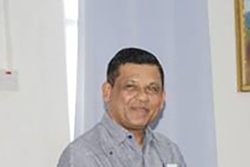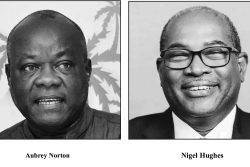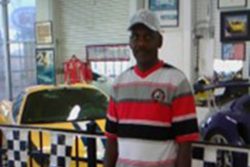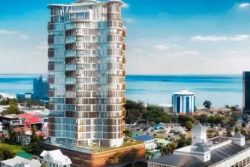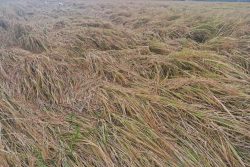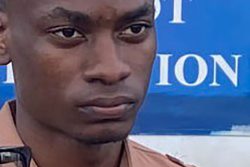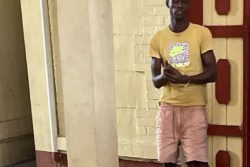Two of Guyana’s cultural and artistic giants were born on November 22 and 23 respectively. To celebrate their birthdays, they got together on the 22nd celebrated through the night until the 23rd so that both birthdays would be given due recognition. I heard the story twice from Stanley Greaves. The first was at an exhibition of new paintings, ‘Dialogue with Wilson Harris,’ in November last year at Castellani House in celebration of his 80th birthday. I heard it again in a brief address by Stanley at a book launching last Monday on the life of the late Wordsworth McAndrew, in which he again related the story. We can only assume that these annual events inspired them to greater achievements.
 Roy Brummel, a widely known educator and folklorist himself, wrote a book, ‘Mih Buddybo Mac’ (My Brother Mac), Part 1, on the life and work of Wordsworth McAndrew, and introduced it to the Guyanese public at Moray House last Monday evening. He also introduced his novel, Halfway Tree, a must read. Roy’s biography of Wordsworth, his novel, the works of Stanley Greaves and of Wordworth McAndrew, show that although circumstances have taken them far from Guyana, Guyana has never been far from them, as Roy said. The creative impetus, inspired by the homeland and the common heritage, remained intact.
Roy Brummel, a widely known educator and folklorist himself, wrote a book, ‘Mih Buddybo Mac’ (My Brother Mac), Part 1, on the life and work of Wordsworth McAndrew, and introduced it to the Guyanese public at Moray House last Monday evening. He also introduced his novel, Halfway Tree, a must read. Roy’s biography of Wordsworth, his novel, the works of Stanley Greaves and of Wordworth McAndrew, show that although circumstances have taken them far from Guyana, Guyana has never been far from them, as Roy said. The creative impetus, inspired by the homeland and the common heritage, remained intact.
Most of Wordworth’s creative efforts took place while he was in Guyana when surrounded by the myths and stories from the nooks and crannies of our past and present and the people who store, relate and believe them. But as one contributor, Professor Ian Robertson, of the University of the West Indies related, Wordsworth created a Guyana environment as best he could while in the US. Stanley Greaves, and now Roy Brummel, continue to add to Guyana’s artistic wealth. Hopefully Wordworth’s “wondrous writings, much of it inspired by the Guyana he had not seen for years,” contained in a “battered knapsack” as described by Sir Ron Sanders when Wordsworth was his houseguest in London, will one day be published.
Wordsworth McAndrew created a body of work of enduring power and beauty, which has inspired many, including Dr Paloma Mohamed, who spoke at the event. At a critical time in our history, when we had just become independent and searching for ourselves, or could have been caught up in nostalgia for the mother country, Wordsworth appeared, as if he was specially sent by a higher power, to demonstrate to us at that precise time when it was necessary, the value and beauty of what Guyana had and help our minds to adjust and transition to a new reality of independence. Described as a “supreme master of Guyanese speech and orality” by Professor Frank Birbalsingh, ‘Ol’ Higue,’ his best known poem, will remain a monument to his creativity and dedication to Guyana.
Reading books on art by the uninitiated is always a task. But not so for Rupert Roopnaraine’s The Primacy of the Eye, the Art of Stanley Greaves. This appreciation of the works of Stanley Greaves, who is also a poet and musician, is gripping, unusual for writings about art. Not only is the book well written, in a style that sustains interest, as one would expect of something coming from Dr Roopnaraine, but the rendering of the subject tells the story of Guyana from the vision of Stanley Greaves. As Dr Roopnaraine said, “if all other records of modern Guyanese life were to disappear, a study of Greaves’s paintings of compassion of the fifties and sixties would be enough to tell us how we lived, what yards and houses we inhabited, what tools our hands held, what musical instruments consoled us, what forms of commerce we engaged in, what hats and pants and dresses and shoes we wore, what leaves and birds and flowers lit up our lives.”
Stanley Greaves’s statements are of universal application derived mainly from Guyanese themes. These indigenous images speak to the world about universal issues and values. In a chapter entitled ‘The Politics of Desolation,’ Roopnaraine examines a series of fourteen paintings starting with ‘Prologue: There is a Meeting Here Tonight.’ First, only someone with Roopnaraine’s specific political background and knowledge of art could have written this chapter. Second, only someone with Greaves’s specific experiences of Guyana and capacity could have executed this series, with their compelling images of dogs, microphones and barrels, representing politicians in their various supplicatory or other endeavours. Commencing the chapter with a review of E R Burrowes’s ‘Guyana, Land of the Dolorous Guard,’ which Roopnaraine described “as fine an image of colonial waste as any,” it sets the tone for the “desolation” of Greaves’s meeting series.
I can do no better than Roopnaraine when he wrote: “I am struck by the extent to which all of these pieces, and indeed all the subsequent pieces over the years…can be seen to constitute a world, with its own internal laws and rhythms, its own codes, its own distinctive aura, an imaginative universe renewing and enlarging itself in a restless dialogue with the real world of men and women and nature.”
